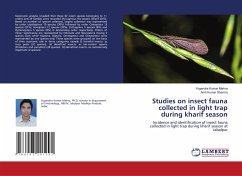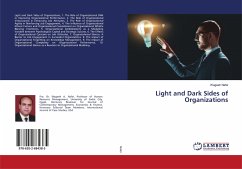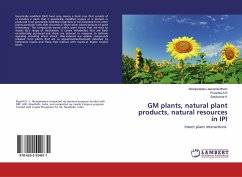
Studies on insect fauna collected in light trap during kharif season
Incidence and identification of insect fauna collected in light trap during kharif season at Jabalpur
Versandkostenfrei!
Versandfertig in 6-10 Tagen
36,99 €
inkl. MwSt.

PAYBACK Punkte
18 °P sammeln!
Taxonomic analysis revealed that these 62 insect species belonging to 11 orders and 34 families were recorded throughout the season (kharif 2015). Based on number of species collected, largest collection was represented by order Lepidoptera 19 species (30%) followed by order Coleoptera 13 species (21%), Hemiptera 12 species (20%), Orthoptera 5 species (8%) and Hymenoptera 5 species (8%) in descending order respectively. Orders of minor significance are represented by Odonata and Neuroptera having 2 species each while Isoptera, Diptera, Dermaptera and Dictyoptera were represented by one species...
Taxonomic analysis revealed that these 62 insect species belonging to 11 orders and 34 families were recorded throughout the season (kharif 2015). Based on number of species collected, largest collection was represented by order Lepidoptera 19 species (30%) followed by order Coleoptera 13 species (21%), Hemiptera 12 species (20%), Orthoptera 5 species (8%) and Hymenoptera 5 species (8%) in descending order respectively. Orders of minor significance are represented by Odonata and Neuroptera having 2 species each while Isoptera, Diptera, Dermaptera and Dictyoptera were represented by one species only. These species were grouped on the basis of their economic role in three categories namely (i) Harmful insects- as crop pests (32 species). (ii) Beneficial insects- as bio-control agents (Predators and parasites) (28 species). (iii) Beneficial insects- as commercially important (2 species).












